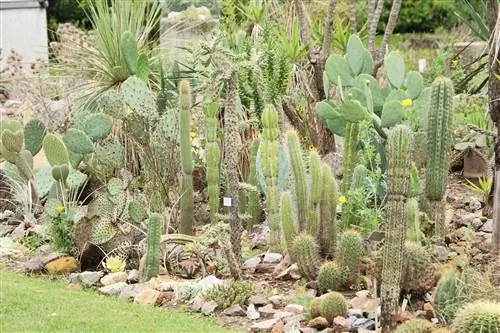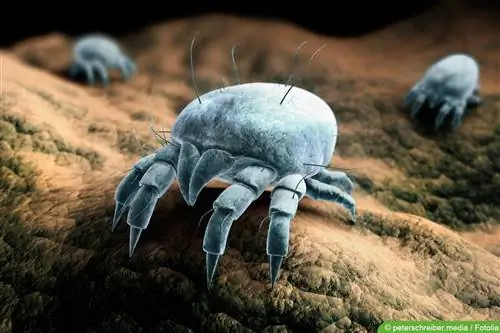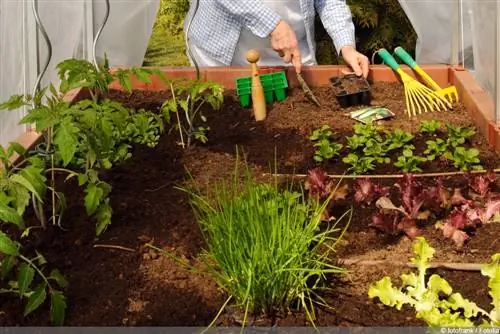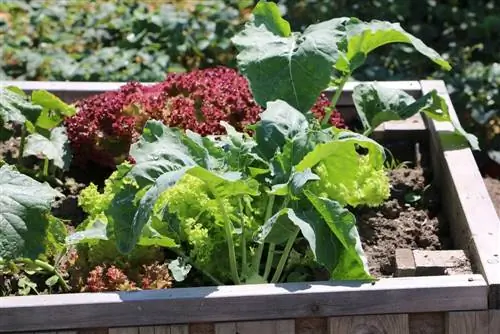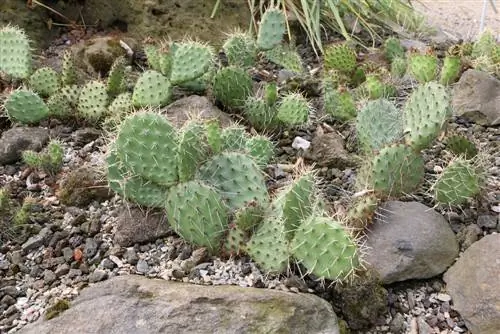- Author admin [email protected].
- Public 2023-12-17 03:39.
- Last modified 2025-06-01 06:48.
Cacti have much more to offer than just a dreary life as a potted plant. Some varieties are extremely robust and can easily withstand temperatures down to -30 °C. Even though the number of enthusiasts is constantly increasing, the exotic plants are still considered a rarity in home gardens. In specially designed beds, passionate hobby gardeners can cultivate cacti outdoors all year round. And if you love a challenge, you can transform your entire garden into a striking succulent landscape.
Exotics for the garden
When the word “cactus” comes to mind, many people inevitably think of film scenes from the Wild West and dry desert landscapes. But cacti are rich in species and have much more to offer visually than just being bizarre, thorny structures in a dry environment. For example, did you know that Selenicereus grandiflorus - the queen of the night - only blooms once a year for a few hours? However, in this short period of time, this cactus variety produces an impressive display of flowers. But other species also have impressive appearances and attractive colors.
Cacti are robust and much easier to care for than is often assumed. However, the exotic plants cannot only be cultivated in the winter garden or on the windowsill at home. Some species are hardy and can remain in the garden all year round. You can easily buy the hardy varieties online or in well-stocked garden centers. However, some preparatory measures are necessary to create a cactus bed or a cactus garden.
Creating a cactus bed correctly
The most important criterion for year-round cultivation of hardy cacti outdoors is drainage. Ideal if the bed or garden area is on a slightly sloping location. But you can also transform flat surfaces into a species-rich cactus landscape. The rainwater must also be able to drain away easily and must not be stored in the ground. The exotic plants require extreme warmth, so the ideal location for the bed should be in a southern location. To build a cactus bed on a slope you need the following materials:
- Weed fleece
- medium gravel
- mineral substrate
- permeable, sandy garden soil
Cacti prefer dry, warm soil. That's why it's not enough to plant the plants in an unprepared substrate. First, stake out the area on which you want to create the cactus bed. At this point you can still make changes and decide on the final bed shape and size. Only then does the actual work begin: First of all, the soil is removed to a depth of around 25 cm. If you enrich it with sand, the substrate can be reused for the bed. The weed fleece forms the basis of the cactus area. This will prevent stubborn root weeds from growing. The drainage layer made of medium-sized pebbles is layered directly above the fleece. This ensures that excess irrigation and rain water can drain away more quickly without damaging the sensitive roots of the cacti. You should spread sandy garden soil on the drainage. In order to promote the resistance and growth of the cacti, an additional 5 to 7 cm high layer of mineral substrate is recommended.
Tip:
Avoid calcareous soil and irrigation water for succulents and cacti. Lime clogs the root membrane and prevents the absorption of moisture and nutrients.
On flat surfaces, you can build a stone wall around the bed. This support means you can do without the weed fleece. Permeable material and a drainage layer made of gravel must also be applied here. Sandstone has proven itself well for the retaining wall, but you can also use stone from the edge of the field. There are hardly any limits to your imagination.
Tips for your individual cactus garden
Filling an entire garden with exotic plants is a challenge, but by no means impossible. Cacti feel particularly at home in rock gardens, but at the same time you can also cultivate other robust plants such as wild perennials, dwarf conifers and slow-growing grasses in such an environment. While the location for a small cactus bed can be found quickly, things often look different for a larger area. Tall trees and walls that cast shadows are often an exclusion criterion for planting cacti over large areas in the garden. In addition to the right soil, the plants need warmth and direct sunlight. A rock garden or bed meets almost all of the requirements of cacti. Clear structures and the materials stone and sand dominate the landscape.
- Terrace-shaped sloping beds create space in small gardens
- Raised beds make your work easier
- massive boulders loosen up the appearance
- larger cacti can be planted solitary
- lay garden paths with gravel or stone slabs
Drainage of the soil is always the priority. Prevent the soil from being able to store large amounts of moisture by replacing large areas of it with mineral substrate. Or use sand to make the soil more permeable. An important point of criticism: In order to successfully cultivate hardy cacti over a large area, you have to redesign your garden from scratch.
Winter-hardy cactus species
The selection of hardy cacti is large, well over 100 different species can easily cope with our cold, wet winters. The following exotic plants should not be missing from any cactus bed or garden:
- Opuntia polyacantha var. hystricina “Cactusmannia”
- Opuntia macrocentra “SB911”
- Cylindropuntia imbricata
- Maihuenia poeppigii “Volcan Antuco Chile”
- Echinocereus xreichenbachii
- Echinocereus triglochidiatus f.inermis
- Pediocactus simpsoni
- Escobaria missouriensisvar. Navajoensis
Inquire about the requirements of each individual cactus variety before you buy. Because some have to be planted in close proximity to the house, others need special protection from rain.
Planting and caring for cacti correctly
Preparing the beds is far from over. There are a few things you should keep in mind when planting and later caring for the cacti. Only insert the cactus root ball halfway into the ground. You can support the part that protrudes above ground with gravel or substrate. Even if only a few cactus species grow quickly or even cover the ground extensively, you should maintain a certain minimum distance between the individual plants. This makes care easier for you, and at the same time the cacti don't compete with each other for water and sunlight. Weeds and rotting shoots on the plants must be removed regularly. To inhibit the growth of unwanted plant species, you can also apply a thicker layer of fine pebbles. During the hot season, water the succulents once a week with lime-free water. A fertilizer containing potassium has proven to be effective for supplying nutrients. This strengthens the tissue of the plants, making the cacti less susceptible to frost.
Conclusion of the editors
Well over 100 different species of cacti impressively prove that succulents don't just thrive in a hot desert landscape. However, to successfully keep the exotic plants in the garden all year round, a lot of work and time is required. Special beds must be created for the plants that need warmth and sun. With a little effort, your own garden can be transformed into an impressive cactus landscape. But don't underestimate how much time you have to invest in the ongoing maintenance of this landscape.
What you should know about cactus beds soon
Substrate
- In order for the cactus bed in the garden to survive periods of rain, a soil mixture of garden soil and mineral components is required.
- The proportion of mineral components should be 50 percent of the total mass.
- It is also important that you only fill the first 4 to 5 cm of soil in the cactus bed with this mineral soil.
- This allows the soil to warm up better and moisture to be better conducted through the soil and drained away.
Wintering
- Frost-hardy cactus varieties can overwinter in the bed: Matucana, Trichocereus, Lobivia, Teprocacteen, Oroya as well as the Echinocereas and the Opuntia.
- Nevertheless, as with all other cacti, the soil in the bed must not be too moist.
- Especially when the temperature falls below 10 °C, you have to make sure that the cacti are not exposed to high humidity.
- If the cactus bed and its succulents are exposed to rain and especially snow, you can cover the bed with fleece.
Planting and caring for it
- When planting cacti, you have to make sure that only half of the root ball is inserted into the ground.
- The rest of the root ball must be filled with gravel, which must be lime-free.
- In the hot summer months, succulents need water and potassium fertilizer once a week.
- This helps strengthen the cacti for the winter as the potassium in the fertilizer strengthens the tissue of the cactus plants.
- Caring for the cactus bed also includes removing weeds and sections of rotten shoots that can cling to the succulents.

